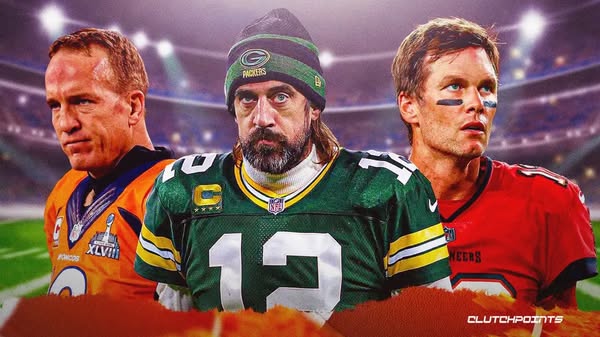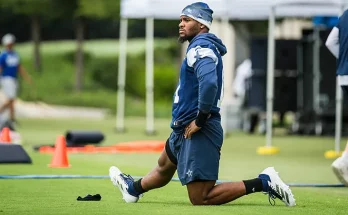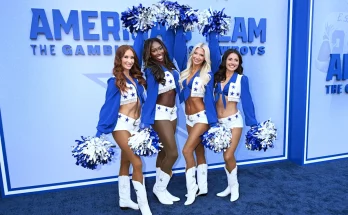The Ultimate Quarterback: Elway Had Favre’s Arm, Young’s Legs, and Montana’s Clutch—A True NFL Legend…
When football historians gather to debate the greatest quarterback of all time, names like Joe Montana, Brett Favre, and Steve Young inevitably come up. Each of them redefined the position in his own way—Montana with his legendary poise and precision under pressure, Favre with his cannon of an arm and fearless improvisation, and Young with his unmatched athleticism and mobility. But when trying to imagine the ultimate quarterback, the ideal blend of traits that define perfection under center, one name consistently rises above the rest: John Elway.
Elway was more than a quarterback; he was a force of nature. The kind of rare talent that seemed carved from the very essence of football itself. He had Brett Favre’s rocket arm, capable of launching passes across the field with velocity and ease. He had Steve Young’s legs, elusive and powerful, allowing him to escape collapsing pockets and turn broken plays into game-changing scrambles. And, perhaps most importantly, he had Joe Montana’s clutch gene—the innate, unteachable ability to rise to the occasion when the game hung in the balance. In Elway, these qualities didn’t just exist in isolation—they converged, creating a quarterback who could beat you in every possible way, on any given Sunday.
Coming out of Stanford, John Elway was already being spoken of in mythical terms. His college career had shown glimpses of the extraordinary—pinpoint throws, impossible comebacks, and jaw-dropping athletic feats. He was the kind of player who seemed destined for greatness, and when the Denver Broncos traded for the No. 1 overall pick to select him in the 1983 NFL Draft, it felt like the birth of something historic. Over the next sixteen seasons, Elway didn’t just live up to expectations—he exceeded them in ways that still echo through NFL lore.
The arm talent was the first thing that caught the eye. Elway could throw a football sixty yards downfield on a rope, a trajectory so flat it looked like a fastball. Defensive backs often talked about the “whistle” of the ball as it flew by, a testament to both the speed and danger of trying to intercept it. Much like Favre, Elway had an almost reckless confidence in his arm. He would attempt throws others wouldn’t dare—into tight windows, across his body, while on the run. And more often than not, he’d complete them. What separated Elway from other strong-armed quarterbacks was his ability to harness that power with touch. He wasn’t just a flamethrower; he could loft passes with delicate arc, thread the needle on slants, and fire darts in the red zone. His arm gave Denver a chance on every play, no matter how dire the situation.
But unlike some classic pocket passers, Elway could also beat you with his legs. In his prime, he was one of the most mobile quarterbacks the league had ever seen. He moved with the speed and agility of a running back, which made him particularly dangerous when a play broke down. Like Steve Young, Elway was never content to simply throw the ball away or take a sack. He could roll out, evade defenders, and either fire a strike downfield or take off for the first down himself. His mobility extended plays that should’ve died, gave receivers time to improvise, and forced defenses to account for every inch of the field. He rushed for over 3,400 yards in his career—an astounding figure in an era when quarterbacks were still largely expected to stay in the pocket.
But arm strength and mobility alone do not make a legend. What elevated Elway to the realm of the all-time greats was his composure in the crucible of pressure. Joe Montana was revered for his calm demeanor in the clutch, most notably orchestrating a 92-yard Super Bowl-winning drive known simply as “The Drive.” But Elway had his own “Drive.” In fact, he had several. The most famous came in the 1986 AFC Championship Game against the Cleveland Browns, when Elway led a 98-yard touchdown march in the closing minutes to tie the game, then win it in overtime. That moment crystallized his legacy as a quarterback who thrived when the stakes were highest. Over his career, Elway engineered 35 game-winning drives in the fourth quarter or overtime. He wasn’t just clutch—he was relentless.
There was something intangible about Elway’s presence on the field. He exuded toughness and leadership, the kind that galvanized his teammates even when the odds were steep. His eyes burned with the quiet confidence of a man who believed, no matter the score, that the game was still his to win. That belief was contagious. Whether trailing late in a playoff game or getting battered by elite defenses, Elway stood tall and kept swinging. His resilience made him the heartbeat of the Broncos and one of the most respected figures in the league.
Elway’s career is often viewed through the lens of his five Super Bowl appearances. For a long time, the narrative centered on his inability to win the big one, as he lost his first three trips to the championship game. But those early defeats only add depth to his story. Lesser players might have folded under the weight of repeated heartbreak. Elway endured, evolved, and finally triumphed—twice. At the end of his career, armed with a dominant running game led by Terrell Davis, Elway led the Broncos to back-to-back Super Bowl victories in 1997 and 1998. The image of him diving head-first into defenders in Super Bowl XXXII, spinning in the air and picking up a critical first down, has become one of the most iconic plays in NFL history. It captured everything Elway was—fearless, determined, and utterly committed to winning.
He retired on top, having secured the championship that had long eluded him, and he did so not as a passenger on a talented team, but as its soul. His final career statistics—over 51,000 passing yards, 300 touchdowns, and nearly 3,500 rushing yards—only tell part of the story. Elway’s legacy lives in the memories of those who watched him defy gravity with deep balls, escape impossible pressure with uncanny footwork, and summon miracles when the clock was running out. He wasn’t just a quarterback—he was a highlight reel in cleats, a walking, talking embodiment of football’s drama and brilliance.
Even after his playing days, Elway continued to shape the NFL. As an executive, he helped build the Denver Broncos into a championship team once again, signing Peyton Manning and constructing a defense that delivered another Lombardi Trophy to the Mile High City. His impact on the game has been multifaceted and lasting. Yet, when people remember John Elway, they don’t talk about boardrooms or scouting decisions—they talk about the moments. The 98-yard drive. The spinning dive in the Super Bowl. The lasers to receivers with barely a sliver of daylight. The sprints that kept plays alive. The fourth quarters that turned to magic.
To compare Elway to Favre, Young, and Montana is to acknowledge the rare overlap of talent he possessed. But it’s more than that. It’s recognizing that he didn’t just borrow traits from these legends—he embodied them all. He had Favre’s daring arm, Young’s kinetic movement, and Montana’s icy calm when everything was on the line. In an era that produced some of the most iconic quarterbacks in history, Elway stood apart because he was a fusion of the very best. He was the ultimate competitor, the ultimate playmaker, the ultimate leader.
In many ways, Elway was a quarterback ahead of his time. The modern NFL celebrates dual-threat QBs who can extend plays with their legs and throw with velocity from any platform. Quarterbacks like Patrick Mahomes, Josh Allen, and Lamar Jackson are praised for their ability to improvise, create, and deliver under pressure. But long before these players took the stage, Elway was doing all of that and more. He was the prototype. The blueprint. The proof that greatness lies not in doing one thing well, but in doing everything better than anyone else.
John Elway wasn’t perfect. He threw interceptions, he lost big games, he had moments of frustration. But that, too, is part of what made him great. He was human, yet he achieved the extraordinary. He failed, and he kept coming back. He battled, and he conquered. And when he finally lifted the Lombardi Trophy, after years of being counted out, the football world didn’t just cheer for a win—they celebrated the journey.
That’s why John Elway isn’t just remembered as a Hall of Famer, or as a Super Bowl champion. He’s remembered as the quarterback who had it all. Favre’s arm. Young’s legs. Montana’s clutch. And above all, Elway’s heart.



